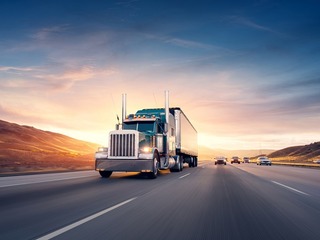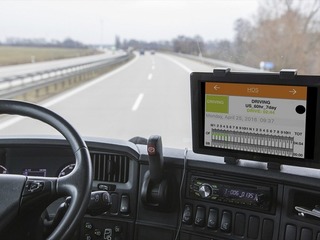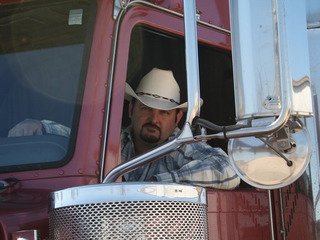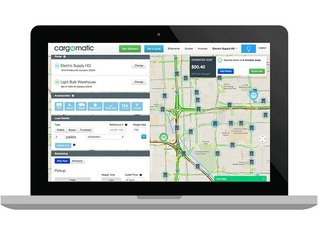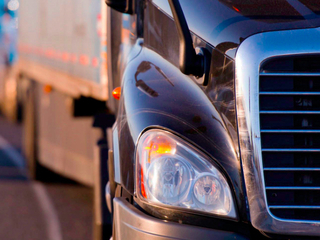The FDA outlines draft guidance on AI for medical devices
The agency also published draft guidance on the use of AI in drug development
Read more...
The current moment seems like a pivotal turning point for the trucking industry. It's a huge space, one that generated $676.2 billion in 2016, or nearly 80 percent of the nation’s freight bill. It's also one that has, for the most part, not been keeping up with current technological trends. But that's suddenly changing.
While part of it has to do with the government stepping in with mandates that are forcing trucking companies to adopt new technologies, that doesn't account for all of the changes that are coming. Some of it is just the inevitability of technology that will eventually change all aspects of society, even those most resistant to it.
It's almost amazing to think how quickly trucking is changing. It's evolving so fast from an industry relying mostly on pencil and paper and now very seriously contemplating a future where trucks will be autonomous. No one is mandating that to happen, but the advancements being made by the consumer industry will, inevitably, make their way into the commercial space as well.
There are a number of questions surrounding autonomous trucking that we all have to consider, including when it will be here, what the cost will be and what, if anything, will stand in its way.
How far away are autonomous trucks?
According to a survey done by PricewaterhouseCoopers and the Manufacturing Institute (MI) of 128 large and mid-sized US manufacturers and transportation companies, a majority of them, 65 percent, said that they believe that self-driving trucks will be mainstream within the next 10 years.
While many seem to believe that autonomous trucking will arrive within the next decade, Shoaib Makani, CEO and co-founder of KeepTruckin, a provider of fleet management solutions and Electronic Logging Devices, believes the timeframe actually depends on what level of autonomy is being discussed. For full autonomy, it might take a while.
"The way we think about this is recognizing there is a world where there will be truly autonomous commercial vehicles. That world isn’t 100 or 50 years away, but it's also not three or five years away," he told me.
"It really depends on the degree of autonomy. Today, even the class A trackers that are rolling off the line aren’t universally deployed. You don’t have things that we are now taking for granted, like lane keeping or adapted cruise control, being broadly available. That is the first step, bringing these things that make life easier for the driver and aid them. Then I believe we do get to a world where platooning and semi-autonomous on interstate highway, long distance travel becomes common. I do think that happens in this five to 10 year window, but the true level 5 autonomy is absolutely, in my view, and I think most experts would agree, 10 plus years out."
Ilya Fushman, Partner at Index Ventures, a firm that has invested in KeepTruckin, also told me that he believes "the timeline is pretty far out" for trucks that can fully drive themselves.
"While it is true that if you think about trucking as a hub-to-hub, and then a hub-to-spoke, distribution system, meaning you have a big hub that’s connected by highways and then goes from that hub into cities, and you can try to simplify the problem by making driving on the highway more autonomous, I don’t think that’s the reality of how the world works," Fushman said.
"I think trucking will benefit tremendously from consumer autonomy but I would wager to say that probably full autonomy will lag for a while, because you have a vehicle that’s moving at three or four times the speed of a city vehicle, with almost 10 times the mass, and it’s just going to be pretty hard to make that autonomous and make sure that if a dog or child runs into the middle of the road that the system can avoid that. The cost of accidents is just very high."
The cost benefits of automation
One of the big benefits of automation in any sector is the potential for cutting costs. According to PwC’s analysis, autonomous trucking would cut costs by 30 percent by 2040, a view shared by the trucking companies, as 90 percent of manufacturers believe that fully autonomous trucks could save them up to 25 percent on their costs.
While the conventional wisdom is that the big cost reductions come from reductions in labor, when it comes to trucking that is most likely not going to be the case, for a few reasons.
Much of the savings will come from making trucking more efficient, said Matt Kropp, CEO of FR8 Revolution, the company behind the FR8Star.com marketplace for open deck carriers and shippers. For instance, he noted that fuel accounts for the same percentage of operations as drivers.
"Even with a driver in the seat but the truck making the acceleration/braking/speed decisions, you can save up to six percent of total operating cost just by improve fuel economy. Safety and liability are also big issues. Using autonomous technology to reduce accidents due to poor driving, distracted driving or drowsy driving reduces accident and repair costs and in the mid-term should reduce insurance premiums as accident rates go down," he said.
There's also the fact that many believe that drivers are still going to be necessary for the so-called "last mile," when the truck has to be unloaded.
"Reducing labor doesn't mean taking the driver out of the truck. High-value and time-sensitive loads are often hauled with two drivers, or 'team drivers,' in the cab so that one drives while the other sleeps. By taking out one of the team drivers you save half the labor cost but have the robot driving while the driver sleeps. This works great for long cross-country runs where the driver handles the pickup and dropoff legs that require negotiating directions into and out of loading docs, leaving the robot to drive the long monotonous straight distance in between," said Kropp.
In fact, rather than cutting into the number of drivers, the opposite might actually happen. There's currently a driver shortage going on, with the ATA estimating a 174,000 driver shortage by 2026, and that is something that automation might actually be able to fix, Fushman believes, by making the job more attractive.
"There are some reports that there’s a shortage of truckers, and that’s happening for a few reasons. The biggest one is that there’s more retail and movement of products happenings across the country, and the second one is that, historically, this market has been underpenetrated by technology," he said.
"We sometimes joke that there’s really not been a lot of innovation in this space since the CB radio and the electronic logging devices that KeepTrucking makes, and the software that they provide to fleets, that they use to better route their trucks and to better communicate and manage their business better, is really transformative to this industry. It makes it a lot more efficient than it is today. You can address the shortages of truckers by making them more efficient and making their lives better so that more people come into the profession.”
Barriers to adoption
So far, however, despite the bullish view on the technology, almost none of the manufacturers and transportation companies that were surveyed companies have actually adopted it. Out of all those surveyed, only 9 percent have implemented any kind of autonomous or semi-autonomous technology.
The overwhelming reason cited for the lack of adoption was the cost, which 60 percent said was their biggest concern. Bill Trenchard, partner at First Round Capital, also told me that he believes that is one of the big obstacles toward adoption.
"The economics for autonomous trucking won't make sense until costs for equipment come down. Waymo's recommended implementation of three LIDAR systems, eight HD cameras and more than two radar sensors would add $200,000 to $400,000 in cost per truck. Just to recoup these costs, trucks would need to be driven close to 24/7 for three years," he said.
Another big barrier cited in the survey were safety issues, with 32 percent saying they have not adopted for this reason. Again, Trenchard agreed with this assessment.
"Safety concerns remain a big sticking point. A fully-loaded semi driving at highway speed packs the same punch as about 10 sticks of dynamite. Right now, the industry still doesn't have the data it needs for fully-automated vehicles to handle inclement weather conditions, difficult terrain or heavily urbanized environments. It's going to be three to five years at least until these challenges can be sufficiently tackled. This means drivers will probably still need to be in every cab for many more years," he said.
Makani, however, believes that it will eventually not be legal to sell a truck that doesn't address those kinds of concerns, and that it might even be mandated by the government.
"I think it’s generally understood that, at some point, non-autonomous vehicles, or vehicles without very significant ADA systems, will not be legal. Safety systems that allow for automatic braking, lane keeping, adaptive cruise, things like that will become, perhaps, mandated. I don’t know the timeline on that by any means, but I don’t believes its unreasonable to believe that," he said.
"I believe there is technology in commercial vehicles in trucking that, while not mandated, is going to become effectively universal, and ELDs are the first sign of that, but there are other safety systems that can be deployed after market, not just by the OEM, that will improve safety and could potentially be a regulatory mandate."
What happens next?
While we wait for full adoption of automation, in the meantime, other technologies will be developed that would pave the way for that technology to flourish.
For Makani, one of the most important developments is the ELD mandate, which forces all trucks to be outfitted with devices that track, manage, and share records of drivers’ on-duty hours. Bringing those trucks online will be the first step toward making automation possible.
"The way we think about the opportunity is, how do we leverage that technology? How do we connect and bring online this industry, in the interim? We think that this mandate, this regulation, serves as a catalyst for connectivity. It has been a very disconnected business and I don’t think that perception is totally unfounded; there’s a lot of paper-based workflows, a lot of manual tasks and behaviors. While the goal of the ELD mandate has been to drive safety, and it will do so, it will also gave a number of follow-on effects around connecting supply side such that you can improve safety, improve utilization, reduce cost and, overall, improve the driver experience," he said.
Fushman believes that, in the meantime, the increase in data will be what drives the technology forward.
"I think intermediate technologies like lane following and distance following and keeping distance, I think those things will probably be adopted more quickly, although I think even they are taking a while to get into the cabin. What’s really important in adoption of all of this stuff, and to really the Holy Grail of autonomy, is getting the data about where everything is going," he said.
"That data is what is going to enable full or partial autonomy to come online, because once you see where things move then you can figure out which lanes are actually possible to drive in autonomous fashion, and which not, and deploy fully or partially autonomous vehicles more appropriately."
One thing we will likely see are more regulations, partially due to the driver shortage, which will relax requirements, said Trenchard. It may also lead to platooning, which involves trucks with drivers, and autonomous trucks in the middle.
"We think this could happen soon, but only if regulations are changed. Right now, a driver is required in every cab and the FMCSA has set strict guidelines that don't allow for longer work hours even if driver-assist technology is being used. Platooning is interesting primarily from a cost perspective, as middle trucks might not need to be equipped to the same level in this use case," he said.
Kropp also mentioned the possibility of what he called "autonomous teams," in which humans and autonomous trucks split the workload.
"With public and regulatory experience from platooning, we will then see driving teams start to be supplanted by a driver plus autonomous, where the driver handles pickup/dropoff and any city driving and then rests while the "autopilot" takes the straight boring highway miles. This has large economic advantage to cutting the labor cost of a team driven load in half while adding low risk autonomous miles."
(Image source: overdriveonline.com)
The agency also published draft guidance on the use of AI in drug development
Read more...The biggest focus areas for AI investing are healthcare and biotech
Read more...It will complete and submit forms, and integrate with state benefit systems
Read more...Angel group/VC
Joined Vator on
Many venture firms would be best described as a collection of free agents who pursue their own deals and share offices and overhead with their partners. They are more mercenary than missionary and will tell you to focus more on the individual partners and less on the partnership. We hope to have the opportunity to show you how we are different.
We are true partners who have built our own firm together, brick by brick; the same way you are building your company. When we commit to supporting your company, each and every partner in our firm commits to contributing his or her network, creativity and resources towards achieving your success. We are big believers in the power of teams.
We believe you will want an investor with whom you can build a close, supportive relationship over a number of years, yet who will be bold enough to challenge your thinking and your expectations. If Index looks like a good fit, we encourage you to learn about us through the stories and news articles on this website. We invite you to read about the companies we have invested in, and to speak to the entrepreneurs we have partnered with. Their experience is our best reference.
Angel group/VC
Joined Vator on
We move at startup speed. We’re transforming a portfolio of individual companies into a connected community of entrepreneurs who inspire, support and educate each other
Startup/Business
Joined Vator on
Book and Dispatch Heavy-Haul Freight
FR8Star.com is a booking and dispatch platform for carriers and shippers moving heavy haul and open deck loads.We have streamlined the entire booking and dispatch process from end-to-end.
We offer our shippers a free patent-pending heavy haul rate calculator so they can instantly estimate their likely freight cost. This calculator includes state-by-state permit fees, escort cars, fuel and more. This calculator helps shippers quickly determine whether or not they're receiving fair quotes from carriers. Shippers have the option of posting their load details in our platform so our network of carriers can directly submit their quotes.
We provide our network of carriers with booking and dispatch tools to help them operate more efficiently and ultimately offer shippers better customer service. We automatically suggest loads to our network of carriers based on a variety of factors including the type and location of their trucks.

Joined Vator on
Matt is CEO of FR8Star.com, the digital marketplace for flatbed and oversized truck freight. Bringing together 10 years starting Internet 1.0 companies and 10 years consulting for truck manufacturers to build a killer team to transform trucking.